Advertisements
Advertisements
प्रश्न
If an object is placed in front of a convex lens beyond 2F1, then what will be the position, relative size, and nature of an image which is formed? Explain with a ray diagram.
उत्तर
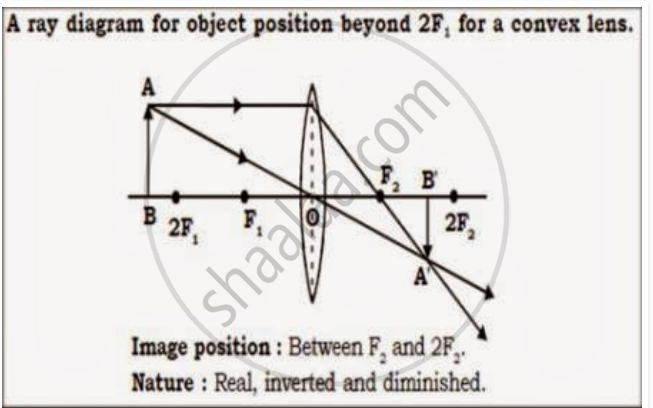
APPEARS IN
संबंधित प्रश्न
Analyse the following observation table showing variation of image-distance (v) with object-distance (u) in case of a convex lens and answer the questions that follow without doing any calculations :
| S. No. | Object-Distance u (cm) |
Image-Distance v (cm) |
| 1 | –100 | +25 |
| 2 | –60 | +30 |
| 3 | –40 | +40 |
| 4 | –30 | +60 |
| 5 | –25 | +100 |
| 6 | –15 | +120 |
(a) What is the focal length of the convex lens? Give reason to justify your answer.
(b) Write the serial number of the observation which is not correct. On what basis have you arrived at this conclusion?
(c) Select an appropriate scale and draw a ray diagram for the observation at S.No. 2. Also find the approximate value of magnification.
Draw a labelled ray diagram to show how a ray of light passes through a parallel sided glass block:
if it hits the glass block at 90° (that is, perpendicular to the glass block)
A 1 cm high object is placed at a distance of 2f from a convex lens. What is the height of the image formed?
Where should an object be placed in order to use a convex lens as a magnifying glass?
If an object is at a considerable distance (or infinity) in front of a convex lens, where is the image formed?
Define principal axis, principal focus and focal length of a convex lens.
How could you find the focal length of a convex lens rapidly but approximately?
Three convex lenses are available having focal lengths of 4 cm, 40 cm and 4 m respectively. Which one would you choose as a magnifying glass and why?
An object is placed f and 2f of a convex lens. Which of the following statements correctly describes its image?
(a) real, larger than the object
(b) erect, smaller than the object
(c) inverted, same size as object
(d) virtual, larger than the object
A convex lens of focal length 8 cm forms a real image of the same size as the object. The distance between object and its image will be:
(a) 8 cm
(b) 16 cm
(c) 24 cm
(d) 32 cm
Calculate the focal length of a convex lens which produces a virtual image at a distance of 50 cm of an object placed 20 cm in front of it.
An object 3 cm high is placed 24 cm away from a convex lens of focal length 8 cm. Find by calculations, the position, height and nature of the image.
How would a pencil look like if you saw it through How would a pencil look like if you saw it through
What kind of lens can form:
an erect magnified image?
A convex lens of focal length 10 cm is placed in contact with a concave lens of focal length 20 cm. The focal length of this combination of lenses will be:
(a) +10 cm
(b) +20 cm
(c) −10 cm
(d) −20 cm
Which part causes the greatest convergence?
What type of lens is used to correct
hypermetropia
The diagram alongside shows the refraction of a ray of light from sir to a liquid.
(a) write the values of (i) angle of incidence, (ii) angle of refraction.
(b) use snell’s law to find the refractive index of liquid with respect to air.
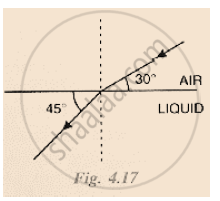
Where is the image formed?
Complete the following table:
| Type of lens | Position of object | Nature of image | Size of image |
| Convex | Between optical centre and focus | ||
| Convex | At focus | ||
| Concave | At infinity | ||
| Concave | At any distance |
State two applications of a convex lens.
When you focus the image of a distant flag, whose shape is given below, on a screen using a convex lens, the shape of the image as it appears on the screen is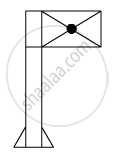
(A)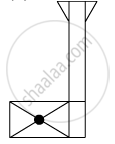
(B)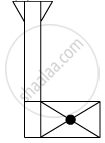
(C)
(D)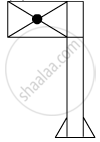
A teacher sets up the stand carrying a convex lens of focal length 15 cm at 42.7 cm mark on the optical bench. He asks four students A, B, C and D to suggest the position of screen on the optical bench so that a distinct image of a distant tree is obtained almost immediately on it. The positions suggested by the students were as
A. 12.7 cm
B. 29.7 cm
C. 57.7 cm
D. 72.7 cm
The correct position of the screen was suggested by
(a) A
(b) B
(c) C
(d) D
List four properties of the image formed by a convex mirror.
For finding the focal length of a convex lens by obtaining the image of a distant object, one should use as the object.
(1) a well lit distant tree
(2) window grill in the class room
(3) any distant tree
(4) a lighted candle kept at the other end of the table.
For which position of the object does a convex lens form a virtual and erect image? Explain with the help of a ray diagram.

i. Which type of microscope has the arrangement of lenses shown in the adjoining figure?
ii. Label the figure correctly.
iii. Write the working of this microscope.
iv. Where does this microscope used?
v. Suggest a way to increase the efficiency of this microscope.
Where should an object be placed in front of a convex lens to get a real image of the size of the object?
Observe the following figure and complete the table:

| Points | Answer |
| (i) Position of the object | |
| (ii) Position of the image | |
| (iii) Size of the image | |
| (iv) Nature of the image |
(a) What type of a lens can be used as a magnifying glass?
(b) Show by a ray diagram the formation of a real image by simple magnifying lens.
Where must a point source of light be placed in front of a convex lens so as to obtain a parallel beam of light?
The focal length of a lens is positive. In this case, state the kind of lens.
State the position of object, position of image, nature of image when: Convex lens is used as an erecting lens in terrestrial telescope.
A concave mirror and convex lens are held in water. What changes, if any, do you expect in their focal length?
In sunglasses, both of its surfaces are curved, yet their behaviour is neither like a convex lens nor like a concave lens. State the reason.
_______ times larger images can be obtained by using a simple microscope.
Write scientific reason.
Adults need bifocal lens spectacle.

The above image shows a thin lens with a focal length of 5m.
- What is the kind of lens shown in the above figure?
- If a real inverted image is to be formed by this lens at a distance of 7m from the optical centre, then show with calculation where should the object be placed.
- Draw a neatly labelled diagram of the image formation mentioned in (ii).
Distinguish between Concave lens and Convex lens.
